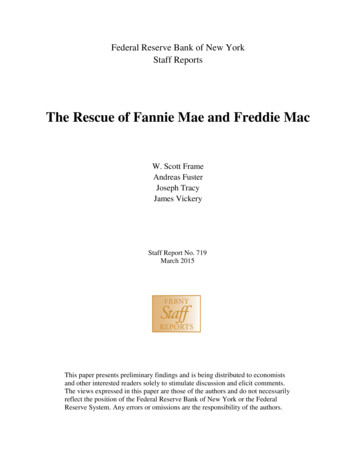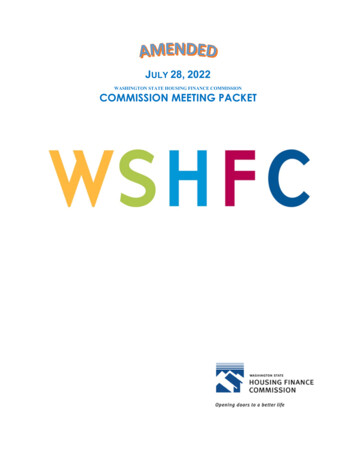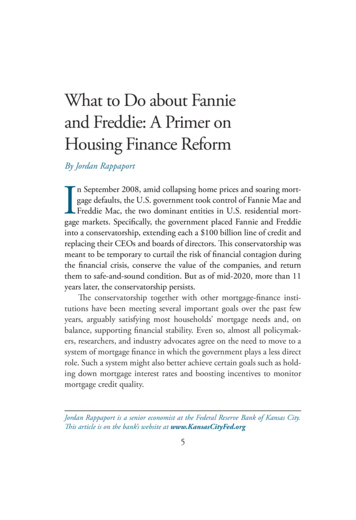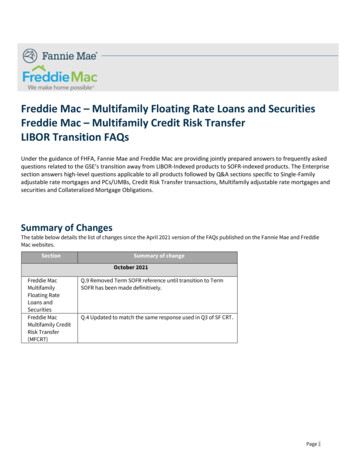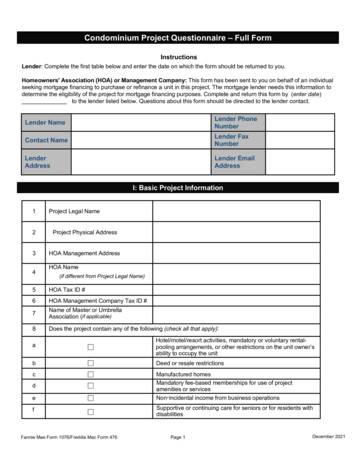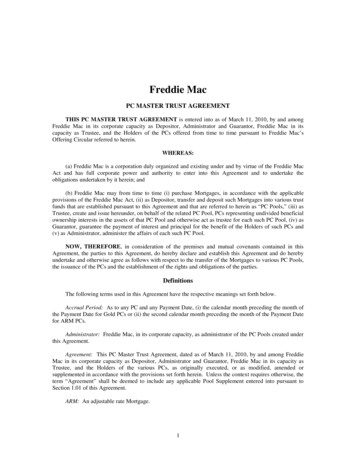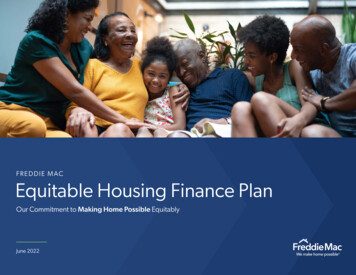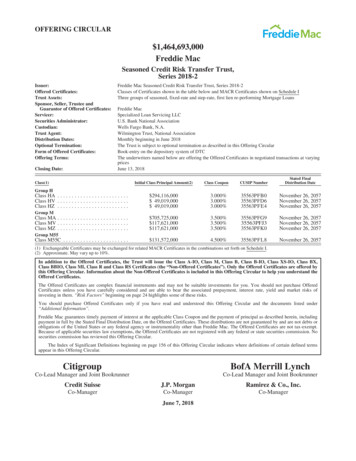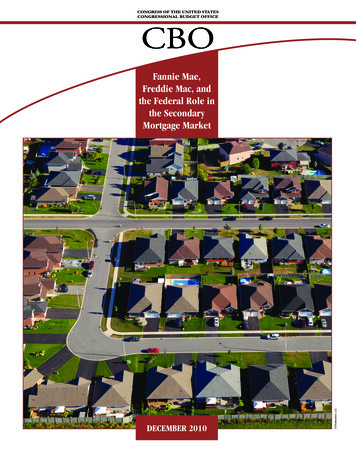
Transcription
CONGRESS OF THE UNITED STATESCONGRESSIONAL BUDGET OFFICECBODECEMBER 2010 Shutterstock, LLCFannie Mae,Freddie Mac, andthe Federal Role inthe SecondaryMortgage Market
Pub. No. 4021
ACBOS T U D YFannie Mae, Freddie Mac, and theFederal Role in theSecondary Mortgage MarketDecember 2010The Congress of the United States O Congressional Budget Office
NoteNumbers in the text and tables for outstanding amounts of mortgage-backed securities(MBSs) guaranteed by Fannie Mae and Freddie Mac exclude the two institutions’ holdings oftheir own MBSs. Those securities are instead reported in the institutions’ mortgage portfolioholdings, which are mostly financed by issuing debt.CBO
PrefaceIn September 2008, the federal government assumed control of Fannie Mae and FreddieMac, two federally chartered institutions that last year guaranteed three-quarters of new residential mortgages originated in the United States. This Congressional Budget Office (CBO)study—prepared at the request of the Chairman of the Senate Committee on Banking, Housing, and Urban Affairs—examines various alternatives for the federal government’s future rolein the secondary (resale) market for residential mortgages. In keeping with CBO’s mandate toprovide objective, impartial analysis, the study does not make any policy recommendations.This study was written by Deborah Lucas and David Torregrosa of CBO’s Financial AnalysisDivision. Priscila Hammett compiled the figures, and Rebecca Rockey fact-checked the manuscript. Kim Cawley, Chad Chirico, Juan Contreras, Mark Hadley, Kim Kowalewski, JoeMattey, Damien Moore, Larry Ozanne, Aurora Swanson, and Steven Weinberg of CBOprovided helpful comments on earlier drafts, as did various people outside CBO, includingRobert Collender, Patrick Lawler, Paul Manchester, Joseph McKenzie, and Robert Seiler Jr.of the Federal Housing Finance Agency; Ron Feldman of the Federal Reserve Bank of Minneapolis; W. Scott Frame of the Federal Reserve Bank of Atlanta; Diana Hancock and WaynePassmore of the Federal Reserve Board; Dwight Jaffee of the University of California at Berkeley; Donald Marron of the Urban-Brookings Tax Policy Center; Joseph Tracy and JoshuaWright of the Federal Reserve Bank of New York; Robert Van Order of George WashingtonUniversity; and Paul S. Willen of the Federal Reserve Bank of Boston. Staff members ofFreddie Mac also provided information, as did Michael Fratantoni of the Mortgage BankersAssociation. (The assistance of outside participants implies no responsibility for the finalproduct, which rests solely with CBO.)Christian Howlett edited the study; Kate Kelly, Leah Mazade, and Sherry Snyder proofread it.Maureen Costantino prepared the report for publication, with assistance from Jeanine Rees,and designed the cover. Monte Ruffin printed the initial copies, Linda Schimmel coordinatedthe print distribution, and Simone Thomas prepared the electronic versions for CBO’s Website (www.cbo.gov).Douglas W. ElmendorfDirectorDecember 2010CBO
ContentsSummaryvii1Overview of Fannie Mae, Freddie Mac, and the Secondary Mortgage Market1The GSEs’ Roles in the Secondary Mortgage MarketChanges in the Secondary Mortgage Market Through Mid-2008Operations of Fannie Mae and Freddie Mac Under Conservatorship1392Possible Rationales for a Federal Role in the Secondary Mortgage Market15Promoting a Stable Supply of Mortgage FinancingPromoting Affordable Housing16183Weaknesses of the Precrisis Model for Fannie Mae and Freddie Mac21Adverse Consequences of the Implicit Federal GuaranteeLimited Effects on Affordable HousingWeak RegulationTensions Between Public and Private Purposes212324244Alternative Approaches for the Future of the Secondary Mortgage Market27Managing the Transition to a New ApproachMajor Design IssuesA Hybrid Public/Private ModelA Fully Federal AgencyA Fully Private Secondary Mortgage MarketOther Mortgage-Financing Approaches283142434547AHistory of the Secondary Mortgage Market51BThe Federal Home Loan Banks55CBO
VICONTENTSTablesS-1.Key Features of Alternatives for the Secondary Mortgage MarketxiiS-2.Key Factors for Assessing Alternatives for the Secondary Mortgage Marketxiv4-1.Key Features of Alternatives for the Secondary Mortgage Market284-2.Key Factors for Assessing Alternatives for the Secondary Mortgage Market30Figures1-1.Outstanding Mortgage-Backed Securities and Portfolio Holdings as a Percentageof the Total Mortgages Backed or Held by the GSEs61-2.Mortgage-Backed Securities, by Issuer71-3.Growth of the GSEs’ Outstanding Mortgage-Backed Securities and Debt81-4.Indexes of Prices for Single-Family Homes, January 1991 ThroughSeptember 201091-5.The GSEs’ Holdings of Private-Label Mortgage-Backed Securities101-6.Outstanding Mortgage Debt111-7.Extent to Which Interest Rates on Freddie Mac’s Ten-Year Debt Exceeded Rateson the Treasury’s Ten-Year Debt, January 2007 Through September 201012Interest Rates on Jumbo and Conforming Mortgages, January 2007 ThroughSeptember 2010131-8.Boxes1-1.CBO’s Budgetary Treatment of Fannie Mae and Freddie Mac44-1.The Market for Private-Label Mortgage-Backed Securities364-2.Preserving the TBA Market and Other Regulatory Features of the Status Quo384-3.Comparing the Public-Utility Model with the Competitive Market-Maker Model40CBO
SummaryTwo years ago, the federal government assumed control of the ailing Federal National Mortgage Association(Fannie Mae) and Federal Home Loan Mortgage Corporation (Freddie Mac), two institutions that facilitate theflow of funding for home loans nationwide. The cost totaxpayers of that takeover, and the structural weaknessesthat contributed to the institutions’ financial problems,have prompted policymakers to consider various alternatives for the government’s future role in the secondary(resale) market for residential mortgages.This study looks at how Fannie Mae and Freddie Macevolved into the institutions they are today. As context fordiscussing future options, the study also examines boththe rationales that are often cited for federal involvementin the secondary mortgage market and the problems withFannie Mae and Freddie Mac that existed before therecent financial crisis. The secondary market channelsfunds to borrowers by facilitating the resale of mortgagesand mortgage-backed securities (MBSs). In that market,lenders such as banks, thrifts, and mortgage companiesobtain funding for the loans they originate by selling theloans to purchasers such as Fannie Mae, Freddie Mac,and other financial institutions (including banks andinsurance companies).Alternative proposals for the secondary mortgage marketinvolve different choices about whether the federal government should continue to guarantee payment on certain types of mortgages or MBSs and, if so, what thescope, structure, and pricing of those guarantees shouldbe. The proposals also involve choices about support foraffordable housing and the competitive structure and regulation of the secondary market. This study examines thetrade-offs involved in making those key design choicesand evaluates the strengths and weaknesses of three broadapproaches for the future of the secondary mortgagemarket:A hybrid public/private model in which the government would help to ensure a steady supply of mortgage financing by providing explicit guarantees onprivately issued mortgages or MBSs that met certainqualifications;A fully public model in which a wholly federal entitywould guarantee qualifying mortgages or MBSs; orA fully private model in which there would be nospecial federal backing for the secondary mortgagemarket.This analysis focuses primarily on the long-term strengthsand weaknesses of the alternative approaches, not on thetransition from the status quo to a new model. Transitional issues—such as what to do with the existing portfolios and obligations of Fannie Mae and Freddie Mac—are important in their own right, but they are largely separate from the questions about the long-term future ofthe secondary mortgage market that are examined here.In particular, alternative ways of resolving the transitionalissues probably would not substantially affect the relativelong-term merits of different models for the secondarymarket, and the different models do not appear to requireany particular resolution of the transitional issues—choices about each could be combined in various ways. Ifchanges were made in the next few years, care would needto be taken not to disrupt the housing and mortgage markets further. Those markets remain fragile: The sharpdecline in housing prices since mid-2006 has left manyhomeowners owing more on their mortgages than theirhomes are worth, foreclosure rates are still high, andobtaining a mortgage continues to be difficult for manyhouseholds.CBO
VIIIFANNIE MAE, FREDDIE MAC, AND THE FEDERAL ROLE IN THE SECONDARY MORTGAGE MARKETFannie Mae, Freddie Mac, and theSecondary Mortgage MarketFour decades ago, Congressional charters set up FannieMae and Freddie Mac as government-sponsored enterprises (GSEs)—privately owned financial institutionsestablished by the government to fulfill a public mission.The two GSEs were created to provide a stable sourceof funding for residential mortgages across the country,including loans on housing for low- and moderateincome families.1 Fannie Mae and Freddie Mac carry outthat mission through their operations in the secondarymortgage market. They purchase mortgages that meetcertain standards from banks and other originators, poolthose loans into mortgage-backed securities that theyguarantee against losses from defaults on the underlyingmortgages, and sell the securities to investors—a processreferred to as securitization. In addition, they buy mortgages and MBSs (both each other’s and those issued byprivate companies) to hold in their portfolios. They fundthose portfolio holdings by issuing debt obligations,known as agency securities, which are sold to investors.Until recently, the GSEs’ debt securities and MBSs werenot officially backed by the federal government. Nevertheless, most investors believed that the governmentwould not allow Fannie Mae and Freddie Mac to defaulton their obligations. That perception of an implicit federal guarantee stemmed from the very prominent role thetwo entities played in the housing market and in thebroader financial markets. It also stemmed from the specific benefits that the two entities received because oftheir status as GSEs, such as not having to register theirsecurities with the Securities and Exchange Commission,being exempt from state and local corporate incometaxes, and having a line of credit with the Treasury.Because of their implicit federal guarantee, Fannie Maeand Freddie Mac could borrow to fund their portfolioholdings at much lower interest rates than those paid byfully private financial institutions that posed otherwisecomparable risks, and investors valued the GSEs’ creditguarantees more highly than those issued by fully private1. The Federal Home Loan Bank System, which is also a GSE, onceplayed a significant role in mortgage finance. But because its focushas broadened beyond housing, and because options for changingthat system involve different considerations than options for thefuture of the secondary mortgage market, this study focuses onFannie Mae and Freddie Mac. (The Federal Home Loan BankSystem is discussed briefly in Appendix B.)CBOguarantors. Some of those benefits from federal supportflowed to mortgage borrowers in the form of greateravailability of credit and somewhat lower interest rates.The GSEs’ other stakeholders (shareholders, managers,and employees) also reaped some of the gains. The advantages of implicit federal support allowed Fannie Mae andFreddie Mac to grow rapidly and dominate the secondarymarket for the types of mortgages they were permittedto buy (known as conforming mortgages). In turn, theperception that the GSEs had become “too big to fail”reinforced the idea that they were federally protected.Fannie Mae and Freddie Mac were profitable in mostyears until recently, when the United States experiencedits most severe financial crisis since the Great Depressionof the 1930s. As housing prices dropped nationwide andforeclosures increased, the two GSEs suffered large losseson various investments in their portfolios, such as subprime mortgages (loans made to borrowers with poorerthan-average credit) and “private-label” MBSs (securitiesissued and insured by private companies without government backing). The GSEs also faced heightened uncertainty about the magnitude of the ultimate decline inhousing prices and increase in unemployment and thusabout the size of credit losses on their outstanding guarantees (which in September 2008 totaled 3.8 trillion).Those factors impaired the GSEs’ ability to issue low-costdebt to fund their mortgage purchases, and doubts aroseabout whether they had enough capital to cover potentiallosses.The enactment of the Housing and Economic RecoveryAct of 2008 (Public Law 110-289) established the FederalHousing Finance Agency and gave it the authority toplace Fannie Mae and Freddie Mac in conservatorship—a step it took in September 2008. The Treasury wasgranted the authority to provide the GSEs with unlimitedcapital (by purchasing their stock) in order to maintaintheir solvency through 2012. Those actions gave the government control over the two institutions and effectivelymade the government’s backing of their debt securitiesand MBS guarantees explicit.As a result of that aid and the explicit federal guarantee,Fannie Mae and Freddie Mac were able to continue channeling funds to the mortgage market, even as privatefinancial institutions were faltering. Consequently, in2009, the two GSEs owned or guaranteed roughly half ofall outstanding mortgages in the United States (includinga significant share of subprime mortgages), and they
SUMMARYFANNIE MAE, FREDDIE MAC, AND THE FEDERAL ROLE IN THE SECONDARY MORTGAGE MARKETfinanced three-quarters of new mortgages originated thatyear. Including the 20 percent of home loans insured byfederal agencies, such as the Federal Housing Administration (FHA), more than 90 percent of new mortgagesmade in 2009 carried a federal guarantee.Possible Rationales for a FederalRole in the Secondary MarketIn assessing future options for Fannie Mae and FreddieMac, a fundamental issue is what role, if any, the federalgovernment should play in the secondary mortgage market. Historically, support for that market has been part ofa broader federal housing policy aimed at encouraginghome ownership and, to a lesser extent, at making housing more affordable for low- and moderate-income families. The activities of Fannie Mae and Freddie Mac havebeen an important aspect of that policy, although thelargest federal subsidies for home ownership have generally come from favorable tax treatment for housing.2Federal policies that affect the secondary market aremainly intended to achieve two public purposes:Helping to ensure a steady supply of financing forresidential mortgages, andProviding subsidized assistance for mortgages onhousing for low- and moderate-income families.The government has pursued those goals largely throughpolicies that increase the liquidity of mortgages andmortgage-backed securities. In a liquid market, investorscan quickly buy or sell large quantities of an asset withoutaffecting its price. The government can enhance theliquidity of the secondary mortgage market by providingcredit guarantees, which make MBSs safer and thus easierfor investors to value, and by standing ready to buy andsell MBSs. Such government support has the greatestimpact on the availability and price of mortgage fundingduring disruptions in the financial markets. At such2. Congressional Budget Office, An Overview of Federal Support forHousing, Issue Brief (November 2009). Some analysts argue thatfederal housing policy has encouraged unsustainable rates of homeownership and overinvestment in housing while reducing investment in sectors of the economy that may be more productive—aview reinforced by the disruptions in the housing market that triggered the recent economic crisis. Those broader issues are beyondthe scope of this analysis, which focuses on federal support for thesecondary mortgage market.IXtimes, interruptions in the supply of mortgage credit canspill over to the market for new-home construction andweaken the broader economy. Such interruptions can alsoimpede labor mobility by making it more difficult forpeople to buy and sell homes when they want to move.Supporting liquidity in the secondary mortgage marketthrough federal credit guarantees tends to lower interestrates only slightly for most mortgage borrowers undernormal market conditions. When mortgages are unsubsidized, the cost of providing a credit guarantee is offset bythe fees charged to investors, and those guarantee fees arepassed on to borrowers. Nevertheless, borrowers maybenefit because investors are willing to pay somewhathigher prices (or, equivalently, accept lower interest rates)for MBSs that are more liquid. In a competitive marketplace, that advantage tends to reduce the rates paid byborrowers relative to what rates would be in the absenceof federal guarantees. (To the extent that Fannie Mae andFreddie Mac are able to dominate the market for MBSs,the value of greater liquidity may accrue largely to themrather than to borrowers.)The benefits of the government’s actions to increaseliquidity in the secondary market by providing creditguarantees and purchasing mortgages must be weighedagainst the costs. Those actions expose taxpayers to therisk of potentially large losses when the cost of honoringguarantees exceeds the value of guarantee fees collected—or when mortgages held by the government lose valuebecause of changes in interest rates or prepayment rates(that is, the extent to which borrowers pay mortgages offearly). Federal guarantees also reduce the incentive formortgage originators to avoid making risky loans in thefirst place.Besides encouraging a stable supply of financing, anotherobjective of federal involvement in the secondary mortgage market is to increase the availability of credit andsubsidize its costs for people with low or moderateincome. Broadening access to home ownership could bebeneficial because owning a home may give people agreater stake in their community and thus make communities more stable. Moreover, certain types of housingassistance may be provided more effectively through support for the secondary market than through grants or taxpreferences. For example, some borrowers may have thefinancial means to own a home but have trouble obtaining private credit—a problem known as “credit rationing.” That problem can occur when it is difficult forCBO
XFANNIE MAE, FREDDIE MAC, AND THE FEDERAL ROLE IN THE SECONDARY MORTGAGE MARKETlenders to assess the riskiness of certain borrowers, such asthose with short credit histories. Lenders cannot addressthat greater risk by charging higher interest rates, becausesuch terms tend to attract borrowers who are more likelyto default. However, the government may decide that thevalue to society from subsidizing certain loans is greaterthan the cost of doing so.Currently, several federal agencies—including the FHA,the Department of Veterans Affairs (VA), and the Government National Mortgage Association (Ginnie Mae)—provide assistance to low- and moderate-income borrowers through the secondary market, as (to a more limitedextent) do Fannie Mae and Freddie Mac. The FHA andVA increase the flow of credit to such borrowers byexplicitly insuring mortgages against losses from default,and Ginnie Mae guarantees the payment of interest andprincipal on MBSs backed by pools of those mortgages.Fannie Mae and Freddie Mac are required to provide support for affordable housing by meeting certain goals setby regulators. Those goals specify the percentage of theGSEs’ mortgage guarantees and purchases that mustinvolve loans used to finance rental housing for, or homepurchases by, people with low or moderate income.Weaknesses of the Precrisis ModelDespite the potential beneficial effects of federal involvement in the secondary mortgage market, the rules andmarket structure under which Fannie Mae and FreddieMac operated before conservatorship—referred to in thisstudy as the precrisis model—had numerous weaknesses.Those weaknesses included the following:Adverse effects from the implicit federal guarantee ofthe two GSEs (such as a concentration of marketpower, risks to the stability of the larger financial system, incentives for excessive risk taking, and a lack oftransparency about costs and risks to the government);Limited effects on affordable housing;Lax regulation; andTensions in trying to balance competing public andprivate goals.The implicit federal guarantee concentrated marketpower in Fannie Mae and Freddie Mac by giving themlower funding costs than potential competitors in theCBOsecondary market. As a consequence, the GSEs grew todominate the segments of the market in which they wereallowed to operate. Because of their size and interconnectedness with other financial institutions, they posedsubstantial systemic risk—the risk that their failure couldimpose very high costs on the financial system and theeconomy. The GSEs’ market power also allowed them touse their profits partly to benefit their other stakeholdersrather than exclusively to benefit mortgage borrowers.The implicit guarantee created an incentive for the GSEsto take excessive risks: Stakeholders would benefit whengambles paid off, but taxpayers would absorb the losseswhen they did not. (Financial institutions that lack thebenefit of a federal guarantee have less incentive to takerisks because doing so can increase their financing costs,although some still act imprudently at times.) One waythat Fannie Mae and Freddie Mac increased risk was byexpanding the volume of mortgages and MBSs held intheir portfolios, which exposed them to the risk of lossesfrom changes in interest or prepayment rates. Over thepast decade, the two GSEs also increased their exposureto default losses by investing in lower-quality mortgages,such as subprime and Alt-A loans.3Because the federal guarantee was implicit rather thanexplicit, the costs and risks to taxpayers did not appear inthe federal budget. That lack of transparency made itmore difficult for policymakers to assess and control theGSEs’ costs and risks. Lack of transparency also made itdifficult for policymakers to evaluate whether the GSEswere effectively and efficiently meeting their affordablehousing goals; several studies have questioned the effectiveness of the GSEs’ affordable-housing activities.Weak regulation was a further shortcoming of the precrisis model. For instance, until 2008, the GSEs’ regulators lacked the power to increase capital requirements forFannie Mae and Freddie Mac or to place them in receivership—powers that regulators have long had over banks.Finally, as private companies with a public mission andimplicit public backing, Fannie Mae and Freddie Macfaced an intrinsic tension in balancing the objectives of3. Subprime and Alt-A mortgages are offered to some borrowers whodo not meet the qualifications for a prime mortgage (one extendedto the least risky borrowers) because of such risk factors as a lowcredit rating, insufficient documentation of income, or the abilityto make only a small down payment.
SUMMARYFANNIE MAE, FREDDIE MAC, AND THE FEDERAL ROLE IN THE SECONDARY MORTGAGE MARKETmaximizing profits for their shareholders, maintainingsafety and soundness to minimize potential costs to taxpayers, and supporting affordable housing. For example,efforts to help low-income households tend to involvetargeting loans toward borrowers who generally posemore risk than borrowers of traditional conformingmortgages do, thereby putting taxpayers at greater riskof loss. The affordable-housing goals and the pursuit ofprofit may have encouraged Fannie Mae and FreddieMac to purchase subprime MBSs that were expected togenerate high returns but that involved excessive risk forborrowers and taxpayers alike.Alternative Approaches for theFuture of the SecondaryMortgage MarketThe weaknesses inherent in the precrisis model may argueagainst returning to that model after the GSEs’ conservatorship ends. A broad array of alternatives are possible forthe federal government’s future role in the secondarymortgage market. Any new approach would need to confront major design issues, such as whether to have federalguarantees and, if so, how to structure and price them;whether to support affordable housing and, if so, by whatmeans; and how to structure and regulate the secondarymarket.The Congressional Budget Office (CBO) analyzed threebroad alternatives for structuring the secondary mortgagemarket (see Summary Table 1):XI(For a synopsis of the trade-offs between the alternativeapproaches, see Summary Table 2 on page xiv).Managing the Transition to a New ApproachMoving from the current operations of Fannie Mae andFreddie Mac under conservatorship to any new modelwould involve several transitional issues, including howto manage the GSEs’ existing portfolios and guaranteeobligations and what to do with their operating assets.The government faces two basic choices: either retain theGSEs’ portfolios and the responsibility for their outstanding guarantees and allow both to run out as mortgages arepaid off, or pay a private entity to assume the guaranteeobligations and sell off the portfolios. Whatever modelfor the secondary market is ultimately adopted, theexpected losses on the GSEs’ existing business will largelybe borne by taxpayers, because private investors wouldnot assume those obligations without compensation. TheGSEs’ operating assets are valuable; they could be auctioned off to investors (with the proceeds helping to offset some of the losses to taxpayers) or kept for use by afederal agency.This study does not address those transitional issues indepth. Handling them efficiently and without disruptionto the secondary mortgage market—especially given current conditions in housing and mortgage markets—isboth important and difficult. However, in CBO’s judgment, those issues have little impact on the relative meritsof various approaches for the long-term organization ofthe secondary market, which is the focus of this study.Major Design IssuesAdopting a hybrid public/private approach that wouldinvolve explicit federal guarantees of some privatelyissued mortgage-backed securities;Establishing a fully federal agency that would purchaseand guarantee qualifying mortgages; orPromoting a fully private secondary market with nofederal guarantees.In examining those broad approaches, CBO looked at anumber of criteria, including whether a given alternativewould ensure a stable supply of financing for mortgages,how affordable-housing goals would be met, how welltaxpayers would be protected from risk, whether federalguarantees would be priced fairly, and to what extent anapproach would provide incentives to control risk taking.Many different models for the secondary mortgage market involve common design issues, such as how to structure and price any federal credit guarantees, whether andhow to support affordable housing, and how to structureand regulate the secondary market.Structuring Federal Guarantees. The design of federalguarantees is an important issue for both a hybrid public/private approach and a fully federal approach. A keychoice involves which mortgages would be consideredeligible for federal guarantees. Mortgage products thatqualify for federal backing tend to be popular, and hencesuch backing can be used to encourage best practices bylenders. Including a wide range of products in the definition of qualifying mortgages—and setting high dollarlimits for those loans—would provide benefits tomore borrowers and could increase the stability of theCBO
XIIFANNIE MAE, FREDDIE MAC, AND THE FEDERAL ROLE IN THE SECONDARY MORTGAGE MARKETSummary Table 1.Key Features of Alternatives for the Secondary Mortgage MarketHybrid Public/Private ModelFully Federal AgencyFully Private MarketExisting operating assetsof Fannie Mae andFreddie MacHanded over to specialized issuers offederally backed MBSs (could be nonprofit, cooperative, or private firms), soldto private-label issuers, or liquidatedUsed for operations of agency,sold to private-label issuers, orliquidatedSold to private-labelissuers or liquidatedLicenses to issuefederally guaranteedMBSsUnder “public-utility model,” only a few;under “competitive market-makermodel,” available to any firm meetingspecified criteriaNone; operations undertakenby agencyNoneFederal guarantees forloans or MBSsExplicit, possibly covering onlycatastrophic risksExplicitNone (Phased out)Private capital’s role insecondary marketAbsorbs most or all losses, except incases of unusually large shocksNone on federally guaranteedsecurities; absorbs all losseson private-label securitiesAbsorbs all lossesAllowable activities forfederally guaranteedsecuritizersUnder “public-utility model,” restrictedto issuing MBSs and holding very limitedportfolios; under “competitive marketmaker model,” restricted only enough tolimit spillover of risk to governmentIssuing guarantees andpossibly holding portfolios ofmortgages and MBSsNot applicableSupport for affordablehousingCould occur through terms on federalguarantees, fees on issuers of federallybacked MBSs, or government agenciesCould occur through agencyNo special role; couldoccur through government agenciesRole of issuers of privatelabel MBSsServe borrowers whose mortgages donot qualify for federal guaranteesServe borrowers whosemortgages do not qualify forfederal guaranteesDominant players insecondary market, alongwith other privatefinancial institutionsSource: Congressional Budget Office.Note: MBSs mortgage-backed securities.secondary market. At the same time, a large-scale guarantee program would expos
Contents CBO Summary vii 1 Overview of Fannie Mae, Freddie Mac, and the Secondary Mortgage Market 1 The GSEs' Roles in the Secondary Mortgage Market 1 Changes in the Secondary Mortgage Market Through Mid-2008 3 Operations of Fannie Mae and Freddie Mac Under Conservatorship 9 2 Possible Rationales for a Federal Role in the Secondary Mortgage Market 15 Promoting a Stable Supply of Mortgage .
